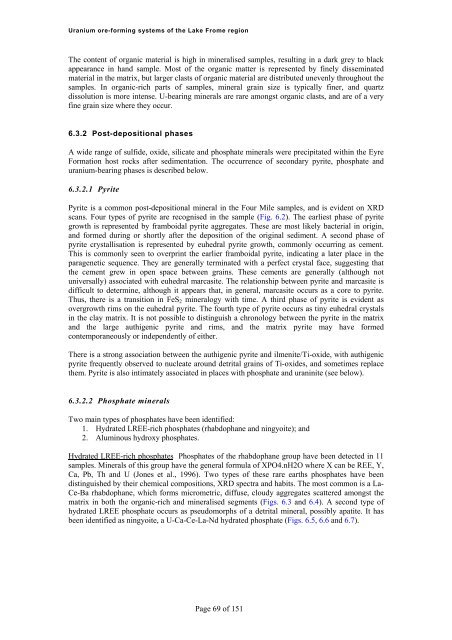Uranium ore-forming systems of the - Geoscience Australia
Uranium ore-forming systems of the - Geoscience Australia
Uranium ore-forming systems of the - Geoscience Australia
Create successful ePaper yourself
Turn your PDF publications into a flip-book with our unique Google optimized e-Paper software.
<strong>Uranium</strong> <strong>ore</strong>-<strong>forming</strong> <strong>systems</strong> <strong>of</strong> <strong>the</strong> Lake Frome regionThe content <strong>of</strong> organic material is high in mineralised samples, resulting in a dark grey to blackappearance in hand sample. Most <strong>of</strong> <strong>the</strong> organic matter is represented by finely disseminatedmaterial in <strong>the</strong> matrix, but larger clasts <strong>of</strong> organic material are distributed unevenly throughout <strong>the</strong>samples. In organic-rich parts <strong>of</strong> samples, mineral grain size is typically finer, and quartzdissolution is m<strong>ore</strong> intense. U-bearing minerals are rare amongst organic clasts, and are <strong>of</strong> a veryfine grain size where <strong>the</strong>y occur.6.3.2 Post-depositional phasesA wide range <strong>of</strong> sulfide, oxide, silicate and phosphate minerals were precipitated within <strong>the</strong> EyreFormation host rocks after sedimentation. The occurrence <strong>of</strong> secondary pyrite, phosphate anduranium-bearing phases is described below.6.3.2.1 PyritePyrite is a common post-depositional mineral in <strong>the</strong> Four Mile samples, and is evident on XRDscans. Four types <strong>of</strong> pyrite are recognised in <strong>the</strong> sample (Fig. 6.2). The earliest phase <strong>of</strong> pyritegrowth is represented by framboidal pyrite aggregates. These are most likely bacterial in origin,and formed during or shortly after <strong>the</strong> deposition <strong>of</strong> <strong>the</strong> original sediment. A second phase <strong>of</strong>pyrite crystallisation is represented by euhedral pyrite growth, commonly occurring as cement.This is commonly seen to overprint <strong>the</strong> earlier framboidal pyrite, indicating a later place in <strong>the</strong>paragenetic sequence. They are generally terminated with a perfect crystal face, suggesting that<strong>the</strong> cement grew in open space between grains. These cements are generally (although notuniversally) associated with euhedral marcasite. The relationship between pyrite and marcasite isdifficult to determine, although it appears that, in general, marcasite occurs as a c<strong>ore</strong> to pyrite.Thus, <strong>the</strong>re is a transition in FeS 2 mineralogy with time. A third phase <strong>of</strong> pyrite is evident asovergrowth rims on <strong>the</strong> euhedral pyrite. The fourth type <strong>of</strong> pyrite occurs as tiny euhedral crystalsin <strong>the</strong> clay matrix. It is not possible to distinguish a chronology between <strong>the</strong> pyrite in <strong>the</strong> matrixand <strong>the</strong> large authigenic pyrite and rims, and <strong>the</strong> matrix pyrite may have formedcontemporaneously or independently <strong>of</strong> ei<strong>the</strong>r.There is a strong association between <strong>the</strong> authigenic pyrite and ilmenite/Ti-oxide, with authigenicpyrite frequently observed to nucleate around detrital grains <strong>of</strong> Ti-oxides, and sometimes replace<strong>the</strong>m. Pyrite is also intimately associated in places with phosphate and uraninite (see below).6.3.2.2 Phosphate mineralsTwo main types <strong>of</strong> phosphates have been identified:1. Hydrated LREE-rich phosphates (rhabdophane and ningyoite); and2. Aluminous hydroxy phosphates.Hydrated LREE-rich phosphates Phosphates <strong>of</strong> <strong>the</strong> rhabdophane group have been detected in 11samples. Minerals <strong>of</strong> this group have <strong>the</strong> general formula <strong>of</strong> XPO4.nH2O where X can be REE, Y,Ca, Pb, Th and U (Jones et al., 1996). Two types <strong>of</strong> <strong>the</strong>se rare earths phosphates have beendistinguished by <strong>the</strong>ir chemical compositions, XRD spectra and habits. The most common is a La-Ce-Ba rhabdophane, which forms micrometric, diffuse, cloudy aggregates scattered amongst <strong>the</strong>matrix in both <strong>the</strong> organic-rich and mineralised segments (Figs. 6.3 and 6.4). A second type <strong>of</strong>hydrated LREE phosphate occurs as pseudomorphs <strong>of</strong> a detrital mineral, possibly apatite. It hasbeen identified as ningyoite, a U-Ca-Ce-La-Nd hydrated phosphate (Figs. 6.5, 6.6 and 6.7).Page 69 <strong>of</strong> 151
















